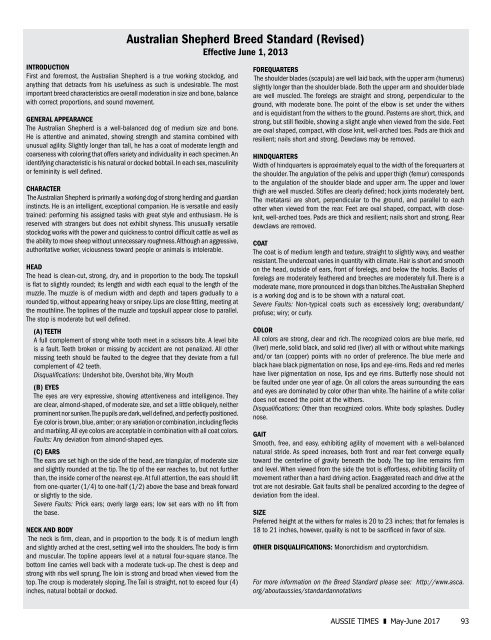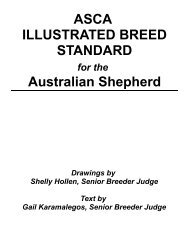Create successful ePaper yourself
Turn your PDF publications into a flip-book with our unique Google optimized e-Paper software.
Australian Shepherd Breed Standard (Revised)<br />
Effective June 1, 2013<br />
INTRODUCTION<br />
First and foremost, the Australian Shepherd is a true working stockdog, and<br />
anything that detracts from his usefulness as such is undesirable. The most<br />
important breed characteristics are overall moderation in size and bone, balance<br />
with correct proportions, and sound movement.<br />
GENERAL APPEARANCE<br />
The Australian Shepherd is a well-balanced dog of medium size and bone.<br />
He is attentive and animated, showing strength and stamina combined with<br />
unusual agility. Slightly longer than tall, he has a coat of moderate length and<br />
coarseness with coloring that offers variety and individuality in each specimen. An<br />
identifying characteristic is his natural or docked bobtail. In each sex, masculinity<br />
or femininity is well defined.<br />
CHARACTER<br />
The Australian Shepherd is primarily a working dog of strong herding and guardian<br />
instincts. He is an intelligent, exceptional companion. He is versatile and easily<br />
trained: performing his assigned tasks with great style and enthusiasm. He is<br />
reserved with strangers but does not exhibit shyness. This unusually versatile<br />
stockdog works with the power and quickness to control difficult cattle as well as<br />
the ability to move sheep without unnecessary roughness. Although an aggressive,<br />
authoritative worker, viciousness toward people or animals is intolerable.<br />
HEAD<br />
The head is clean-cut, strong, dry, and in proportion to the body. The topskull<br />
is flat to slightly rounded; its length and width each equal to the length of the<br />
muzzle. The muzzle is of medium width and depth and tapers gradually to a<br />
rounded tip, without appearing heavy or snipey. Lips are close fitting, meeting at<br />
the mouthline. The toplines of the muzzle and topskull appear close to parallel.<br />
The stop is moderate but well defined.<br />
(A) TEETH<br />
A full complement of strong white tooth meet in a scissors bite. A level bite<br />
is a fault. Teeth broken or missing by accident are not penalized. All other<br />
missing teeth should be faulted to the degree that they deviate from a full<br />
complement of 42 teeth.<br />
Disqualifications: Undershot bite, Overshot bite, Wry Mouth<br />
(B) EYES<br />
The eyes are very expressive, showing attentiveness and intelligence. They<br />
are clear, almond-shaped, of moderate size, and set a little obliquely, neither<br />
prominent nor sunken. The pupils are dark, well defined, and perfectly positioned.<br />
Eye color is brown, blue, amber; or any variation or combination, including flecks<br />
and marbling. All eye colors are acceptable in combination with all coat colors.<br />
Faults: Any deviation from almond-shaped eyes.<br />
(C) EARS<br />
The ears are set high on the side of the head, are triangular, of moderate size<br />
and slightly rounded at the tip. The tip of the ear reaches to, but not further<br />
than, the inside corner of the nearest eye. At full attention, the ears should lift<br />
from one-quarter (1/4) to one-half (1/2) above the base and break forward<br />
or slightly to the side.<br />
Severe Faults: Prick ears; overly large ears; low set ears with no lift from<br />
the base.<br />
NECK AND BODY<br />
The neck is firm, clean, and in proportion to the body. It is of medium length<br />
and slightly arched at the crest, setting well into the shoulders. The body is firm<br />
and muscular. The topline appears level at a natural four-square stance. The<br />
bottom line carries well back with a moderate tuck-up. The chest is deep and<br />
strong with ribs well sprung. The loin is strong and broad when viewed from the<br />
top. The croup is moderately sloping. The Tail is straight, not to exceed four (4)<br />
inches, natural bobtail or docked.<br />
FOREQUARTERS<br />
The shoulder blades (scapula) are well laid back, with the upper arm (humerus)<br />
slightly longer than the shoulder blade. Both the upper arm and shoulder blade<br />
are well muscled. The forelegs are straight and strong, perpendicular to the<br />
ground, with moderate bone. The point of the elbow is set under the withers<br />
and is equidistant from the withers to the ground. Pasterns are short, thick, and<br />
strong, but still flexible, showing a slight angle when viewed from the side. Feet<br />
are oval shaped, compact, with close knit, well-arched toes. Pads are thick and<br />
resilient; nails short and strong. Dewclaws may be removed.<br />
HINDQUARTERS<br />
Width of hindquarters is approximately equal to the width of the forequarters at<br />
the shoulder. The angulation of the pelvis and upper thigh (femur) corresponds<br />
to the angulation of the shoulder blade and upper arm. The upper and lower<br />
thigh are well muscled. Stifles are clearly defined; hock joints moderately bent.<br />
The metatarsi are short, perpendicular to the ground, and parallel to each<br />
other when viewed from the rear. Feet are oval shaped, compact, with closeknit,<br />
well-arched toes. Pads are thick and resilient; nails short and strong. Rear<br />
dewclaws are removed.<br />
COAT<br />
The coat is of medium length and texture, straight to slightly wavy, and weather<br />
resistant. The undercoat varies in quantity with climate. Hair is short and smooth<br />
on the head, outside of ears, front of forelegs, and below the hocks. Backs of<br />
forelegs are moderately feathered and breeches are moderately full. There is a<br />
moderate mane, more pronounced in dogs than bitches. The Australian Shepherd<br />
is a working dog and is to be shown with a natural coat.<br />
Severe Faults: Non-typical coats such as excessively long; overabundant/<br />
profuse; wiry; or curly.<br />
COLOR<br />
All colors are strong, clear and rich. The recognized colors are blue merle, red<br />
(liver) merle, solid black, and solid red (liver) all with or without white markings<br />
and/or tan (copper) points with no order of preference. The blue merle and<br />
black have black pigmentation on nose, lips and eye-rims. Reds and red merles<br />
have liver pigmentation on nose, lips and eye rims. Butterfly nose should not<br />
be faulted under one year of age. On all colors the areas surrounding the ears<br />
and eyes are dominated by color other than white. The hairline of a white collar<br />
does not exceed the point at the withers.<br />
Disqualifications: Other than recognized colors. White body splashes. Dudley<br />
nose.<br />
GAIT<br />
Smooth, free, and easy, exhibiting agility of movement with a well-balanced<br />
natural stride. As speed increases, both front and rear feet converge equally<br />
toward the centerline of gravity beneath the body. The top line remains firm<br />
and level. When viewed from the side the trot is effortless, exhibiting facility of<br />
movement rather than a hard driving action. Exaggerated reach and drive at the<br />
trot are not desirable. Gait faults shall be penalized according to the degree of<br />
deviation from the ideal.<br />
SIZE<br />
Preferred height at the withers for males is 20 to 23 inches; that for females is<br />
18 to 21 inches, however, quality is not to be sacrificed in favor of size.<br />
OTHER DISQUALIFICATIONS: Monorchidism and cryptorchidism.<br />
For more information on the Breed Standard please see: http://www.asca.<br />
org/aboutaussies/standardannotations<br />
AUSSIE TIMES May-June <strong>2017</strong> 93



